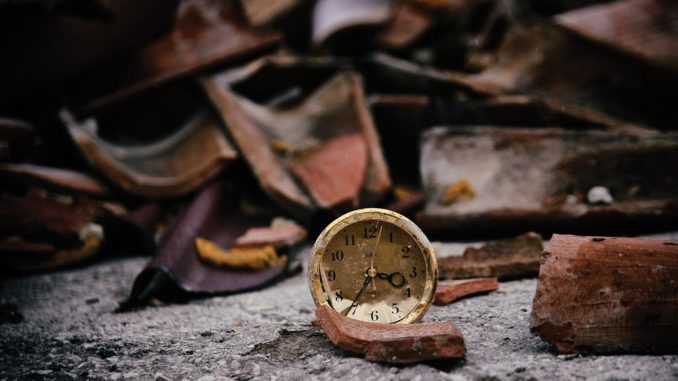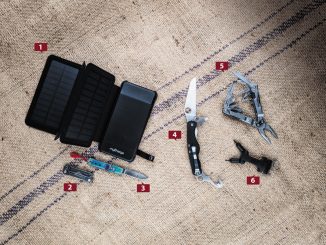
The first 30 minutes after the SHTF could be the most critical moments of your life and the lives of the ones you love. This short window could easily make the difference between whether you survive or just become another tragic statistic.
If my more than 25 years of service with the U.S. Army and the Special Forces taught me anything, it was that proper prior planning prevents piss-poor performance when things start to go downhill around you. You can have all the “high-speed/low-drag” gear that money can buy, and it won’t mean a damned thing if you have not devised a solid plan that you rehearsed and improved upon long before a SHTF event takes place.
I am not going to fill this article with long lists of things you need to purchase to get ready for the apocalypse; there are more than a few such articles, books and videos on just that topic. So, I will only say that thinking you are going to go to the grocery store, the pharmacy or Wal-Mart after a SHTF scenario kicks off is a lot of wishful thinking. If the past is indicative of what the future holds, you can look at any time the United States was hit by a major storm to be reminded that the shelves will empty almost immediately. The time to stock up on food, water, fuel, guns, ammunition and medical supplies is now. Enough said.
Setting Priorities
So, now that we are prepared for the worst life has to offer, what do we do when the time comes to put all that preparation and training to use?
Priority number one: security, security, security! Are you safe from any immediate threat? Can you help others to safety? This must take priority above all other situations that might be developing around you.

In a life-and-death scenario as a result of which your loved ones are vulnerable and in danger, your first priority, above all others, needs to be security.
In combat, when one of my comrades gets wounded, he is left to tend to his own wounds while the rest of us neutralize the immediate threat. Once we are able to suppress the enemy contact and are confident that the situation is secure enough, we go to the aid of the wounded. When the SHTF, it might not be a conventional direct-fire combat scenario, but the approach should be similar, and it will serve you well to adopt it in a new and uncertain world.
You can have all the “high-speed/low-drag” gear that money can buy, and it won’t mean a damned thing if you have not devised a solid plan that you rehearsed and improved upon long before a SHTF event takes place.

One of the reasons to get away from huge population centers after a catastrophe is that there will be so many people competing for so few resources— which so often leads to violence and theft.
Your security and that of your loved ones takes precedence over medical aid, food, water, shelter … everything. Falling victim yourself because you failed to react in a timely manner is not going to do anyone any good. Break contact from the immediate threat, dress your wounds and the wounds of those you are with, and then, you can move on to the next step of assessing what has happened.
Determining the Scenario
Once you are safe from any immediate threat, it is time to identify the problem. This might not be as easy as it sounds—particularly in a situation where all lines of communication might have been shut off, such as after an EMP (electromagnetic pulse). Certain government entities, the military and even some preppers might have the capability to maintain communication after such an event, but the general public most likely will not be able to contact authorities and others who could have critical information about what the current situation is.
Priority number one: security, security, security! Are you safe from any immediate threat? Can you help others to safety?
In cases other than a grid-down situation, news on television and radio stations through the Emergency Alert System should be able to give you some idea of what the situation is so you can decide what to do next. In the event that such information is not readily available, you’ll have to do some investigating of your own before moving to the next step.

You don’t have to look too hard around the world to find examples—such as the war-torn Syrian landscape depicted here—of what could happen if a major catastrophic event were to play out in the United States.
First, assuming that the power grid has been affected, you will want to know what type of power outage has occurred. If it was just a standard outage, certain electronic items, such as your cell phone or flashlight, should still work.
You should also check your vehicle to see if it is functioning properly. Cars made after the late 1980s to early 1990s have a considerable amount of electronics that can be rendered nonfunctional by EMPs. This doesn’t necessarily mean an EMP will keep your vehicle from starting; we just can’t know now what would happen if such an event occurred. It would be dependent on the location, strength and altitude of the EMP itself, as well as how well protected the electronic equipment in your vehicle is.

If you wait too long to bug out, the roads will eventually jam up as cars begin to overheat or run out of fuel—at which point driving out will become futile.
Many preppers keep HAM radios and other electronic equipment inside a Faraday cage or similar enclosures to protect them from EMPs. The bottom line is that you will have to use all your situational awareness to determine the most likely scenario you are dealing with and then move on to step two and plan for the worst case.
Bug In or Bug Out?
The next step is situationally dependent. Obviously, if you are in the vicinity of “ground zero” of any disaster, your first priority is to put as much distance between yourself and the immediate danger as quickly as possible. Assuming the threat is not immediate, you need to make a decision to bug in or bug out. If you are planning to bug in, there are a few things you can do to prolong your survivability in the days, weeks, and even months and years to come.

HAM radios are an outstanding way to stay in contact with others and to keep informed of the emergency situation when other lines of communication are not available.

A TV monitor shows the first test of the new Emergency Alert System (EAS) on November 9, 2011, in Washington, D.C. EAS alerts are transmitted over radio and television broadcast stations, cable television and other media services. (Photo: Karen Bleier/AFP/Getty Images)
Water should be one of your first priorities, depending on where you live, what the nature of the event was and what type of water system provides you with fresh drinking water. Fill all your sinks, tubs and spare containers with fresh water from the faucet. There is no telling how long the water will continue to flow, and you can expect to go through your water supply quite quickly, even at the conservative estimate of 2 gallons per day per person for drinking water, personal hygiene and cooking.

Keeping an emergency get-home bag in your vehicle at all times will ensure you always have what you need in the event you are forced to abandon your vehicle and move on foot to get back home.

If the phone lines or cell towers are still functioning, take advantage of them by calling all your loved ones and letting them know the time has come to drop what they are doing and move to the predetermined rendezvous location.
Even if you already have a dependable natural water source or are stocked up on water, it can never hurt to have a little more until you figure things out. Therefore, I would suggest storing every bit of water you can as soon as possible after a SHTF event begins.
The time to stock up on food, water, fuel, guns, ammunition and medical supplies is now. Enough said.
Remember that emergency situations such as this are often quite fluid, and what is a safe haven one day might be overrun by lawless hordes the next. Because of this, it is a smart idea to have a bug-out bag (BOB) for each member of your party packed and ready to go at a moment’s notice. There is plenty of information online (including at ASGMAG.com) concerning what to put in your BOB. Be careful, though, because some sites will have you put together an 80- to 100-pound BOB that you can barely lift or carry.

The time to build your bug-out bag and stock up on emergency supplies is now—not after an emergency has occurred.
Keep in mind that first and foremost, this is your bag, and its contents might be the only possessions you will bring to a new and uncertain location, so pack it according to your plan, needs and capabilities.

Make sure your bug-out plan is appropriate for the needs of all those in your family unit, including children, the elderly, pets and anyone with special needs.
You must be brutally honest with yourself. If you are an overweight 40-something who has a bum shoulder, the Spec-Ops Grappling Hook you purchased online is probably not going to do you much good; maybe you should consider a tube of Aspercreme and a reusable heat pack instead.
Finally, as quickly as possible, attempt to communicate with the remainder of your party in order to get them all back to your home location or ensure they have a safe place to take refuge. This can be a difficult task, because phone lines, if still intact, could be jammed with call volume.

If the catastrophic event that takes place involves chemical, biological, radiological or nuclear contamination, it is absolutely imperative to seek out a decontamination station as quickly as possible. Monitor the media for information on locations of decontamination stations erected nearest to your location.

Often, the average American family is spread out across the state, country and even the world. If it’s a plausible option, it is imperative to have a plan for rallying together as soon as possible after disaster strikes. Put it into place now, because you can’t always count on electronic means to facilitate this reunion, and you will not have time to devise and communicate a plan while you’re taking care of business at home.
In the event you are forced to leave your home, leaving a load signal for the missing members of your party will let them know where you have gone so they can head there themselves.
It is also quite possible you will have to evacuate your homestead location before all members of your party are reunited there. In the Special Forces, when we engage in evasion and recovery operations, we set something called a “load signal,” which is nothing more than a visual signal displayed in a covert manner to indicate the presence of an individual at a given location. This technique will work well to assist in letting members of your party know you have left your homestead and are headed to your bug-out location.

Make sure everyone in your family has an appropriately sized backpack that is not so heavy they could not carry it for long distances.
In the event you are forced to leave your home, leaving a load signal for the missing members of your party will let them know where you have gone so they can head there themselves. The signal can really be anything, as long as it can’t be easily removed, and everyone in your party knows what it represents. They should know where to go in the event of a major catastrophe and what to do next if it is not possible to go to the original link-up spot.
Formulate an Appropriate Plan
Your plan will be unique to your needs and situation, but the important thing is that everyone knows and has rehearsed the plan with all the parties involved so you can work out any flaws prior to having to put it into practice.
Remember that emergency situations such as this are often quite fluid, and what is a safe haven one day might be overrun by lawless hordes the next.

If your bug-out plan is to go into the wilderness and live off the land, you had better become highly proficient at doing so long before such a decision becomes necessary to execute. Many people have starved to death in natural resource-rich environments due to inexperience, ignorance and unwarranted confidence in their own ability to survive in the outdoors.

Accurately shooting a firearm and being able to employ one in a life-or-death situation is a highly perishable skill set. You are no more than a liability if you own a firearm and don’t regularly practice using it.

Being able and ready to make a fire is an essential skill you must master.
Once you are in a relatively safe location, it is a smart idea to team up with other like-minded and trustworthy individuals in your area. This larger group can assess the situation at large and start delegating priorities of work so you can pool resources, skills and manpower for the betterment of all. A true SHTF situation will be difficult—if not impossible—to go through alone, and you will need all the help you can get.

It is a good practice to always keep on hand at least 90 days’ worth of all your most vital prescription medications in the event an emergency occurs that would leave pharmacies’ shelves empty.

Fresh water should be one of your first priorities directly after an emergency situation takes place. Fill all your tubs, sinks and spare containers with water from the faucet.
Remember, you have to come up with a plan that fits your group and your needs so that you’ll be organized and ready to move within 30 minutes after a catastrophic event strikes. If you have very young, very old or very sick members to take care of, you need to take that into consideration when you formulate your plan.
Failing to act swiftly and purposefully directly after a SHTF scenario occurs could squander all your preparations and training.

In the event of a national disaster, it is quite possible that martial law will be declared. In such a case, you can expect curfews, armed military patrols on the streets and extreme restrictions on your freedom of movement.

If a national disaster or catastrophic event occurs, FEMA (the Federal Emergency Management Agency) will almost certainly establish local displaced- person camps for citizens who were forced to leave their homes. While this might be a viable option for you, there is no guarantee as to how quickly these camps will be established or information about how quickly they will reach maximum capacity after an emergency occurs.
God willing, a doomsday scenario will never happen to you, and life will go on in relative peace and harmony. But if the stuff ever does hit the fan, you have an opportunity now to prepare for it and potentially save the lives of everyone and everything that means anything to you by being ready to act quickly and decisively. Failing to act swiftly and purposefully directly after a SHTF scenario occurs could squander all your preparations and training. Plan now so that when/if the time comes, you will be ready to survive and thrive in an uncertain and volatile future.
Editor’s note: A version of this article first appeared in the March, 2018 print issue of American Survival Guide.





Be the first to comment